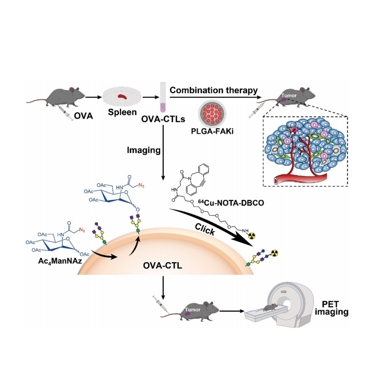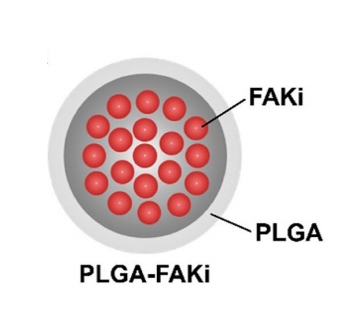文献:Metabolic radiolabeling and in vivo PET imaging of cytotoxic T lymphocytes to guide combination adoptive cell transfer cancer therapy
文献链接:
https://jnanobiotechnology.biomedcentral.com/articles/10.1186/s12951-021-00924-2?utm_source=xmol&utm_medium=affiliate&utm_content=meta&utm_campaign=DDCN_1_GL01_metadata作者:Dehua Lu, Yanpu Wang, Ting Zhang, Feng Wang, Kui Li, Shixin Zhou, Hua Zhu, Zhi Yang, and Zhaofei Liu
相关产品:PEG-PLGA(聚乙二醇-聚乳酸-羟基乙酸共聚物)
原文摘要:
Background: Adoptive T cell transfer-based immunotherapy yields unsatisfactory results in the treatment of solid tumors, partially owing to limited tumor infltration and the immunosuppressive microenvironment in solid tumors. Therefore, strategies for the noninvasive tracking of adoptive T cells are critical for monitoring tumor infltration and for guiding the development of novel combination therapies.
Methods: We developed a radiolabeling method for cytotoxic T lymphocytes (CTLs) that comprises metabolically labeling the cell surface glycans with azidosugars and then covalently conjugating them with 64Cu-1,4,7-triazacyclononanetriacetic acid-dibenzo-cyclooctyne (64Cu-NOTA-DBCO) using bioorthogonal chemistry. 64Cu-labeled controlCTLs and ovalbumin-specifc CTLs (OVA-CTLs) were tracked using positron emission tomography (PET) in B16-OVA tumor-bearing mice. We also investigated the efects of focal adhesion kinase (FAK) inhibition on the antitumor efcacy of OVA-CTLs using a poly(lactic-co-glycolic) acid (PLGA)-encapsulated nanodrug (PLGA-FAKi).
Results: CTLs can be stably radiolabeled with 64Cu with a minimal efect on cell viability. PET imaging of 64Cu-OVACTLs enables noninvasive mapping of their in vivo behavior. Moreover, 64Cu-OVA-CTLs PET imaging revealed that PLGA-FAKi induced a signifcant increase in OVA-CTL infltration into tumors, suggesting the potential for a combined therapy comprising OVA-CTLs and PLGA-FAKi. Further combination therapy studies confrmed that the PLGA-FAKi nanodrug markedly improved the antitumor efects of adoptive OVA-CTLs transfer by multiple mechanisms.
Conclusion: These fndings demonstrated that metabolic radiolabeling followed by PET imaging can be used to sensitively profle the early-stage migration and tumor-targeting efciency of adoptive T cells in vivo. This strategy presents opportunities for predicting the efcacy of cell-based adoptive therapies and for guiding combination regimens.
PEG - PLGA 是一种嵌段共聚物,由聚乙二醇(PEG)和聚乳酸 - 羟基乙酸共聚物(PLGA)两个部分组成。PEG 是一种亲水性聚合物,其分子链含有多个乙二醇单元,具有良好的水溶性和生物相容性。PLGA 是由乳酸(LA)和羟基乙酸(GA)两种单体通过缩聚反应形成的无规共聚物,具有可生物降解的特性。在 PEG - PLGA 中,PEG 链段和 PLGA 链段通过化学键连接在一起,这种结构使得共聚物兼具两者的特点。基于PEG - PLGA的性质,PLGA-FAKi的合成如下:

图:机制示意
PLGA-FAKi的制备与表征:
PF-562271是一种FAK抑制剂(FAKi),溶解于二甲亚砜中,加入聚乙二醇-聚乳酸-羟基乙酸共聚物(PEG-PLGA;50:50(w/w);Mw~5000:10000Da;)。PF-562271与PLGA聚合物安一定比例混合。取少量的反应混合物滴入水中。搅拌,静置后,将含pf-562271的PLGA纳米颗粒(PLGA-FAKi),离心5,用PBS洗涤。利用动态光散射测量了PLGA-FAKi的粒径分布和zeta势,并利用JEM-1400透射电子显微镜对PLGA-FAKi的形貌进行了表征。PF-562271的Te释放率采用紫外可见检测器的HPLC进行测定。

图:合成品示意
结论:
该文献成功制备出基于PEG - PLGA合成的PLGA-FAKi。成像显示,PLGA-FAKi诱导了OVA-CTL膨胀进入tumour的明显增加,显示了包括OVA-CTL和PLGA-FAKi在内的潜力。研究表明,PLGA-FAKi纳米化合物通过多种机制改善了过继性ova-ctl转移的抗tumour作用。

 2025-02-11 作者:ws 来源:
2025-02-11 作者:ws 来源:

